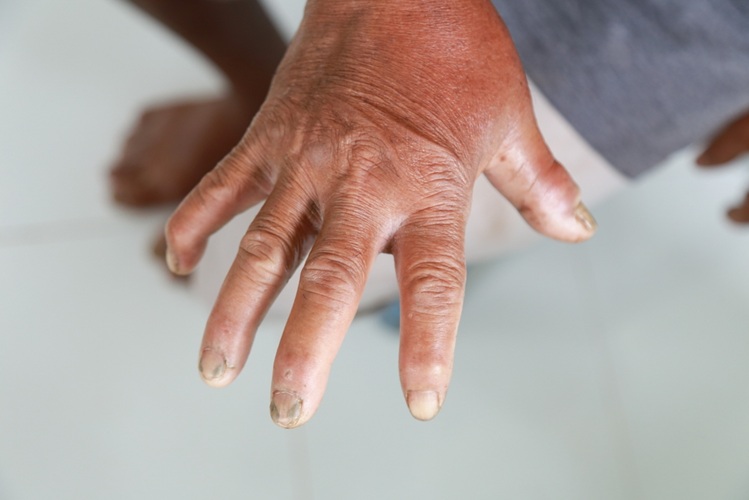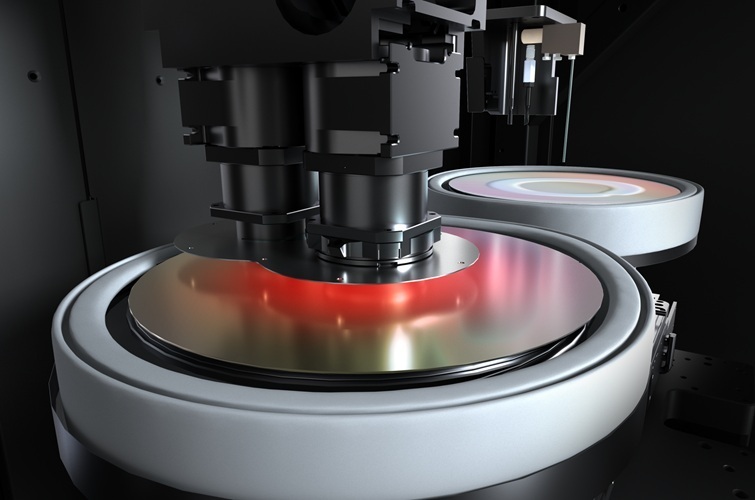Rapid Serological Assay Developed for Strongyloidiasis
|
By LabMedica International staff writers Posted on 19 Aug 2014 |

Image: The adult free-living female Strongyloides stercoralis with a row of eggs within the body of the nematode (Photo courtesy of the CDC - Centers for Disease Control and Prevention).
Several imperfect methods exist for diagnosing strongyloidiasis and stool examination with microscopic identification of larvae considered the gold standard diagnostic procedure, showing good specificity with experienced staff.
Individuals with strongyloidiasis are typically asymptomatic, and the infection can persist for decades without detection. Problems arise when individuals with unrecognized Strongyloides stercoralis infection are immunosuppressed, which can lead to hyper-infection syndrome and disseminated disease with an associated high mortality if untreated.
An international team of scientists led by those at McGill University (Montreal, QC, Canada) obtained 54 positive serum samples that were confirmed by positive stool samples for S. stercoralis from multiple reference laboratories. There were 47 negative control samples consisted of sera obtained from healthy individuals residing in Canada with no prior history of travel outside of Canada and individuals with confirmed diagnosis of other parasitic infections, including trichinosis, and were negative for Strongyloides by an “in-house” enzyme-linked immunoassay (ELISA) (NRCP).
The team developed a rapid and sensitive serodiagnostic assay for strongyloidiasis based on a 31-kDa recombinant antigen from S. stercoralis (NIE) using a novel diffraction-based optical biosensor technology. The panelPlus oligonucleotide-based addressing system was used for NIE immobilization onto dotLab Sensors and All assays were performed on the dotLab mX System using panelPlus D Sensors (Axela, Inc.; Toronto, ON, Canada). All serum samples were also tested by an NIE ELISA that was developed and validated.
The assay readily differentiated S. stercoralis-infected patients from controls detecting 96.3% of the positive cases, and with no cross reactivity observed in the control group. These results were in excellent agreement with results obtained by an NIE-based ELISA. A further 44 sera from patients with suspected S. stercoralis infection were analyzed and showed 91% agreement with the NIE ELISA. The novel, high-sensitivity diffractive optics technology (dot) platform generated results in less than 30 minutes and is fully automated requiring minimal user intervention. This makes it potentially attractive for near-patient testing and for use in regions where technical expertise or adequate laboratory facilities may not be available.
The authors concluded that with the ability to create custom multiplex assays using the panelPlus oligonucleotide-based addressing system, the dotLab mX System could also be used further to improve Strongyloides serodiagnostics by incorporating multiple recombinant antigens in a multiplex format or by simultaneously screening for clinically relevant co-infections such as Human T-cell lymphotropic virus type 1 (HTLV-1).
The study was published on August 7, 2014, in the journal Public Library of Science Neglected Tropical Diseases.
Related Links:
McGill University
Axela Inc.
Individuals with strongyloidiasis are typically asymptomatic, and the infection can persist for decades without detection. Problems arise when individuals with unrecognized Strongyloides stercoralis infection are immunosuppressed, which can lead to hyper-infection syndrome and disseminated disease with an associated high mortality if untreated.
An international team of scientists led by those at McGill University (Montreal, QC, Canada) obtained 54 positive serum samples that were confirmed by positive stool samples for S. stercoralis from multiple reference laboratories. There were 47 negative control samples consisted of sera obtained from healthy individuals residing in Canada with no prior history of travel outside of Canada and individuals with confirmed diagnosis of other parasitic infections, including trichinosis, and were negative for Strongyloides by an “in-house” enzyme-linked immunoassay (ELISA) (NRCP).
The team developed a rapid and sensitive serodiagnostic assay for strongyloidiasis based on a 31-kDa recombinant antigen from S. stercoralis (NIE) using a novel diffraction-based optical biosensor technology. The panelPlus oligonucleotide-based addressing system was used for NIE immobilization onto dotLab Sensors and All assays were performed on the dotLab mX System using panelPlus D Sensors (Axela, Inc.; Toronto, ON, Canada). All serum samples were also tested by an NIE ELISA that was developed and validated.
The assay readily differentiated S. stercoralis-infected patients from controls detecting 96.3% of the positive cases, and with no cross reactivity observed in the control group. These results were in excellent agreement with results obtained by an NIE-based ELISA. A further 44 sera from patients with suspected S. stercoralis infection were analyzed and showed 91% agreement with the NIE ELISA. The novel, high-sensitivity diffractive optics technology (dot) platform generated results in less than 30 minutes and is fully automated requiring minimal user intervention. This makes it potentially attractive for near-patient testing and for use in regions where technical expertise or adequate laboratory facilities may not be available.
The authors concluded that with the ability to create custom multiplex assays using the panelPlus oligonucleotide-based addressing system, the dotLab mX System could also be used further to improve Strongyloides serodiagnostics by incorporating multiple recombinant antigens in a multiplex format or by simultaneously screening for clinically relevant co-infections such as Human T-cell lymphotropic virus type 1 (HTLV-1).
The study was published on August 7, 2014, in the journal Public Library of Science Neglected Tropical Diseases.
Related Links:
McGill University
Axela Inc.
Latest Microbiology News
- Handheld Device Delivers Low-Cost TB Results in Less Than One Hour
- New AI-Based Method Improves Diagnosis of Drug-Resistant Infections
- Breakthrough Diagnostic Technology Identifies Bacterial Infections with Almost 100% Accuracy within Three Hours
- Innovative ID/AST System to Help Diagnose Infectious Diseases and Combat AMR
- Gastrointestinal Panel Delivers Rapid Detection of Five Common Bacterial Pathogens for Outpatient Use
- Rapid PCR Testing in ICU Improves Antibiotic Stewardship
- Unique Genetic Signature Predicts Drug Resistance in Bacteria
- Unique Barcoding System Tracks Pneumonia-Causing Bacteria as They Infect Blood Stream
- Rapid Sepsis Diagnostic Test Demonstrates Improved Patient Care and Cost Savings in Hospital Application
- Rapid Diagnostic System to Detect Neonatal Sepsis Within Hours
- Novel Test to Diagnose Bacterial Pneumonia Directly from Whole Blood
- Interferon-γ Release Assay Effective in Patients with COPD Complicated with Pulmonary Tuberculosis
- New Point of Care Tests to Help Reduce Overuse of Antibiotics
- 30-Minute Sepsis Test Differentiates Bacterial Infections, Viral Infections, and Noninfectious Disease
- CRISPR-TB Blood Test to Enable Early Disease Diagnosis and Public Screening
- Syndromic Panel Provides Fast Answers for Outpatient Diagnosis of Gastrointestinal Conditions
Channels
Clinical Chemistry
view channel
New Method Uses Pulsed Infrared Light to Find Cancer's 'Fingerprints' In Blood Plasma
Cancer diagnoses have traditionally relied on invasive or time-consuming procedures like tissue biopsies. Now, new research published in ACS Central Science introduces a method that utilizes pulsed infrared... Read more
Carbon Nanotubes Help Build Highly Accurate Sensors for Continuous Health Monitoring
Current sensors can measure various health indicators, such as blood glucose levels, in the body. However, there is a need to develop more accurate and sensitive sensor materials that can detect lower... Read moreMolecular Diagnostics
view channel
Gene-Based Blood Test Accurately Predicts Tumor Recurrence of Advanced Skin Cancer
Melanoma, an aggressive form of skin cancer, becomes extremely difficult to treat once it spreads to other parts of the body. For patients with metastatic melanoma tumors that cannot be surgically removed... Read more
Blood Test Could Identify Patients at Risk for Severe Scleroderma
Systemic sclerosis, also known as scleroderma, causes the hardening of the skin and connective tissues. In many cases, the disease can also damage vital organs, including the heart, kidneys, lungs, and... Read moreHematology
view channel
New Scoring System Predicts Risk of Developing Cancer from Common Blood Disorder
Clonal cytopenia of undetermined significance (CCUS) is a blood disorder commonly found in older adults, characterized by mutations in blood cells and a low blood count, but without any obvious cause or... Read more
Non-Invasive Prenatal Test for Fetal RhD Status Demonstrates 100% Accuracy
In the United States, approximately 15% of pregnant individuals are RhD-negative. However, in about 40% of these cases, the fetus is also RhD-negative, making the administration of RhoGAM unnecessary.... Read moreImmunology
view channel
Stem Cell Test Predicts Treatment Outcome for Patients with Platinum-Resistant Ovarian Cancer
Epithelial ovarian cancer frequently responds to chemotherapy initially, but eventually, the tumor develops resistance to the therapy, leading to regrowth. This resistance is partially due to the activation... Read more
Machine Learning-Enabled Blood Test Predicts Immunotherapy Response in Lymphoma Patients
Chimeric antigen receptor (CAR) T-cell therapy has emerged as one of the most promising recent developments in the treatment of blood cancers. However, over half of non-Hodgkin lymphoma (NHL) patients... Read morePathology
view channel
New Error-Corrected Method to Help Detect Cancer from Blood Samples Alone
"Liquid biopsy" technology, which relies on blood tests for early cancer detection and monitoring cancer burden in patients, has the potential to transform cancer care. However, detecting the mutational... Read more
"Metal Detector" Algorithm Hunts Down Vulnerable Tumors
Scientists have developed an algorithm capable of functioning as a "metal detector" to identify vulnerable tumors, marking a significant advancement in personalized cancer treatment. This breakthrough... Read more
Novel Technique Uses ‘Sugar’ Signatures to Identify and Classify Pancreatic Cancer Cell Subtypes
Pancreatic cancer is often asymptomatic in its early stages, making it difficult to detect until it has progressed. Consequently, only 15% of pancreatic cancers are diagnosed early enough to allow for... Read moreTechnology
view channel
Pain-On-A-Chip Microfluidic Device Determines Types of Chronic Pain from Blood Samples
Chronic pain is a widespread condition that remains difficult to manage, and existing clinical methods for its treatment rely largely on self-reporting, which can be subjective and especially problematic... Read more
Innovative, Label-Free Ratiometric Fluorosensor Enables More Sensitive Viral RNA Detection
Viruses present a major global health risk, as demonstrated by recent pandemics, making early detection and identification essential for preventing new outbreaks. While traditional detection methods are... Read moreIndustry
view channel
Cepheid and Oxford Nanopore Technologies Partner on Advancing Automated Sequencing-Based Solutions
Cepheid (Sunnyvale, CA, USA), a leading molecular diagnostics company, and Oxford Nanopore Technologies (Oxford, UK), the company behind a new generation of sequencing-based molecular analysis technologies,... Read more
Grifols and Tecan’s IBL Collaborate on Advanced Biomarker Panels
Grifols (Barcelona, Spain), one of the world’s leading producers of plasma-derived medicines and innovative diagnostic solutions, is expanding its offer in clinical diagnostics through a strategic partnership... Read more























